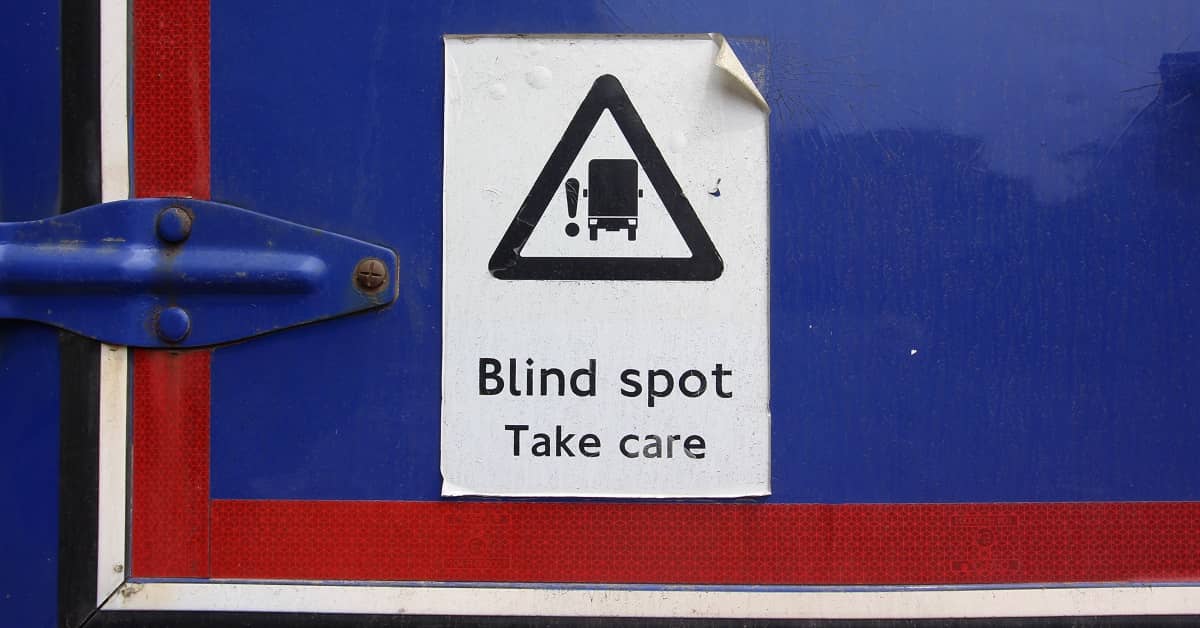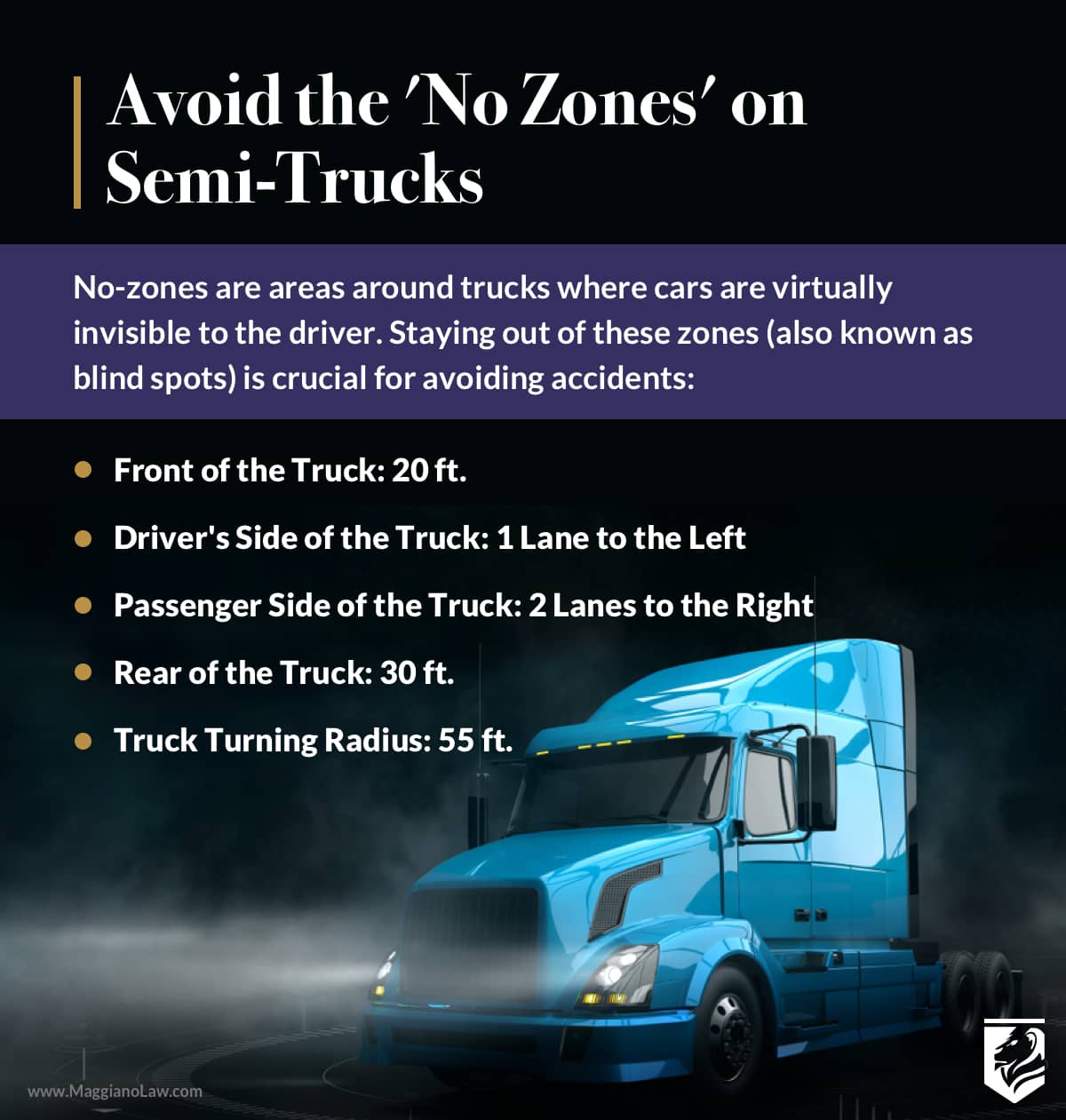
What Are Truck ‘No Zones’?
All vehicles have blind spots. The bigger the vehicle, the larger the blind spot. Due to their large size, semi-trucks have significant blind spots at the front, sides, and back of the rig and the trailer. These areas are sometimes called “no-zones” to reflect the danger posed to the drivers of passenger vehicles who are in close proximity to large trucks.
No-zones are areas around trucks where cars are virtually invisible to the driver. We all share the roads with commercial trucks. As such, we must all drive responsibly and follow the rules of the road. This is why all drivers must be aware of truck no-zones.
If you have been injured or lost a loved one in an accident with a semi-truck, you should speak to a truck accident lawyer as soon as possible. Maggiano, DiGirolamo & Lizzi serves clients throughout New Jersey and New York.

What Are the No-Zones for Large Trucks?
The drivers of cars and motorcycles face a number of hazards when sharing the road with large trucks. Since 1994, the Federal Motor Carrier Safety Administration (FMCSA) has raised awareness of how motorists can safely drive around and pass heavy commercial vehicles.
The number-one tip for drivers in the current FMCSA campaign (“Our Roads Our Safety”): Stay out of blind spots. Drivers need to be aware of the no-zones when making lane changes, passing a tractor-trailer, and traveling in front of or behind a semi.
Because of the dangers they pose, every driver must beware of no-zones. There are multiple no-zones to be aware of when you are sharing the road with a truck, bus, or other heavy vehicle.
Side No-Zones
Trucks and buses have large blind spots on both sides that are much larger than your car’s blind spots. If you can’t see the driver’s face in the side-view mirror, the driver will not be able to see you.
The no-zone on the driver’s side of the truck takes up one lane extending from the driver’s side mirror to about the middle of the trailer. The no-zone on the passenger side is much larger; drivers should avoid being even with the front of the cab in the lane immediately to the right of the truck, while drivers two lanes over on the passenger side should stay an entire truck-length behind.
Rear No-Zone
Trucks and buses also have no-zones behind them. Drivers of these large vehicles are unable to see immediately to the rear, and you will not be able to see what is going on ahead of you.
According to the FMCSA, the rear no-zone stretches 30 feet behind the truck. It is best to allow even more space if you are traveling at high speeds, as large trucks and buses require more room to stop.
When driving behind a truck or bus, you must pay close attention so that you have somewhere to go if the driver brakes or stops suddenly. You should also remember never to cross behind a truck that is backing up.
Front No-Zone
You should never cut in front of a bus or truck too soon after passing. The driver will be forced to slam on the brakes, and the longer stopping distance may result in a rear-end collision with your car.
The front no-zone extends 20 feet in front of the truck. If you can see the entire front of the vehicle in your rearview mirror, you are generally at a safe distance.
Before changing lanes, look behind you in the mirror to make sure you can see the front of the truck or the bus. Once you change lanes, maintain a consistent speed so you can stay out of the front no-zone.
Wide Right Turns
With a turning radius of 55 feet, the drivers of 18-wheelers often need to swing wide to the left before they can safely execute a right turn. As they make the turn, they will not be able to see the cars behind or beside them.
If you are traveling beside or behind a commercial vehicle, you need to be aware of potential wide turns. You should also never try to squeeze in between a turning truck or bus and the curb. Passenger vehicles trying to enter this small space are likely to be crushed.
Read More: Commercial Truck and Passenger Vehicle Accidents
How Can I Avoid Accidents Involving Truck No-Zones?
Staying out of the no-zone of a truck or bus comes down to awareness. As with reducing your risk for any type of auto accident, focus and sound judgment are key for avoiding the blind spots on a commercial vehicle.
You can protect yourself from no-zone accidents with these steps:
- Watch your speed: Drivers commonly enter the no-zone of a truck or bus without realizing it. This often occurs because they are driving faster than the posted speed limit or decelerate too much. It is important to modify your speed when you are driving near a truck so you can maintain a safe distance.
- Use caution when passing: Passing a truck should be done quickly and carefully. Although you want to get out of the no-zones as soon as possible, it is also important to stay alert so you can safely navigate the lane next to the truck and re-enter your original lane without cutting off the commercial vehicle.
- Avoid distractions: Distracted driving is a major cause of accidents. If you are distracted and your vehicle is in the blind spot of a truck, you will have very little time to react if the truck driver slams on the brakes or changes lanes.
- Adjust your mirrors: Proper positioning of your car’s mirrors is key for being aware of other vehicles. Here are some ways that you can adjust your mirrors to minimize your chances of an accident:
- Driver’s side mirror: When you sit with your hands on the steering wheel, lean to the left. Then adjust the mirror until your car appears on the inside edge of the reflected image.
- Passenger-side mirror: Lean your head toward the center of the vehicle and adjust until the right side of the car appears on the inside edge of the mirror.
- Adjustment testing: Hit the road and test the adjustments. If a car passes you, it should appear in the outside mirror before leaving the rearview mirror.
Unfortunately, even if you take all of these precautions, you may still be involved in a serious wreck. Truck driver negligence is a common factor in claims involving accidents with large trucks. Oftentimes the drivers of trucks and buses fail to check their blind spots, leading to collisions where the people in passenger vehicles are significantly more likely to suffer serious and even fatal injuries.
Contact a Truck Accident Lawyer Today
Blind spot accidents with trucks, buses, and other large vehicles can be catastrophic. Litigation involving these collisions can be complicated. For these reasons, it is crucial to speak to an attorney as soon as possible after any commercial vehicle accident.
The attorneys at Maggiano, DiGirolamo & Lizzi have decades of experience representing clients in accident claims involving private and commercial carriers. We have achieved significant results on behalf of those who have been severely injured and lost ones to the carelessness of commercial drivers.
View Our Verdicts & Settlements
Please call Maggiano, DiGirolamo & Lizzi at (201) 585-9111 today for a free case evaluation. Our truck accident lawyers serve clients throughout New Jersey and New York.


















